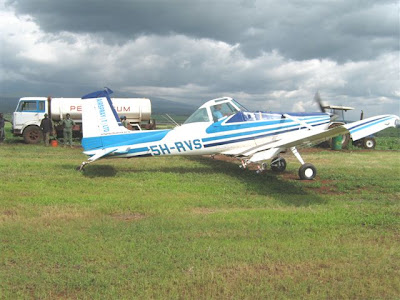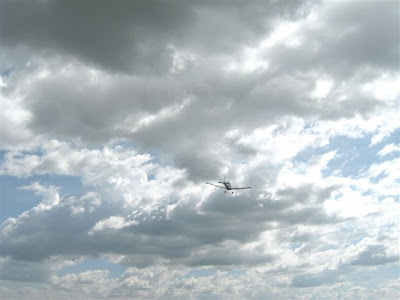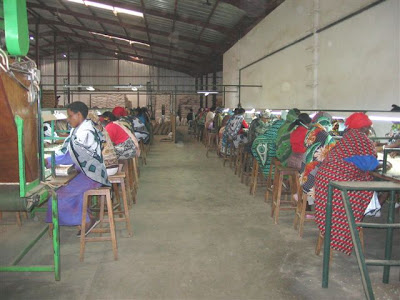Staff on standby at our airstrip with the water bowser and aircraft fuel
Due to the large size of our farm (3500 acres) our crops are often sprayed by air. There've also been times when we've suddenly had a crop disease (or insect infestation) and have had to quickly call in the air sprayers in order to get the situation under control quickly - as spraying by air is much quicker than doing it on the ground.
Our farm has it's own 'bush' airstrip for light aircraft and is well maintained (eg. if we needed to use it in a hurry for a medical emergency / Flying Doctors). Our air sprayers (a father & son team from Kenya) are well known to us and have sprayed for us for years now - both here and on our old farm.
Intense spraying programmes where you are meeting tight deadlines (due to disease or changing weather conditions) mean that sometimes the spraying lasts for several days - so our air sprayers have become regular guests in our home, staying over with us and entertaining us with incredible stories of crop spraying all over remote parts of the African continent - and have become good friends over the years ! (I've also served many a 'picnic' breakfast or lunch at the airstrip as they've had no time to stop - grabbing what they can on landing, to eat in the cockpit as they continue spraying, before swooping down for the next course as they re fuel the 'plane !)

The modified Cessna single engine spray 'plane on our farm airstrip
I always know when the crop sprayers are due in, and without fail they announce their arrival by swooping LOW over the house - so low that they can see right in the windows as they approach ! (They joke that this is to see what I am up to & keep me on my toes !) They do the same thing when they leave - we are usually all out on the front lawn (including the house staff and dogs - who bark madly at the 'plane and try to chase it !) In fact, this is pretty much the 'tradition' here in Tanzania with light aircraft. Whenever we have people flying in/out of the farm they always swoop low over the house (as you would toot the horn on your car) when arriving and leaving .... but none as low as the crop sprayers dare !
 Our crop sprayers are two of the hardest working people I've come across & work from sunrise to sunset if weather conditions are good
Our crop sprayers are two of the hardest working people I've come across & work from sunrise to sunset if weather conditions are good
The spray 'plane is a modified single engine Cessna and lands frequently during a day of spraying in order to refuel (we keep AvGas or Aviation Fuel for this purpose) and fill it's spray tanks up with insecticide. This is mixed on the ground and we have a crew of farm staff standing by to help mix and put it into the aircraft's tanks. We also have a mobile water bowser on the airstrip as the insecticide usually has to be mixed/diluted with water.
 The spray 'plane is just visible on the horizon as it sprays a field of our wheat
The spray 'plane is just visible on the horizon as it sprays a field of our wheat
If you click the photo above to enlarge it, you can just see the 'plane spraying on the horizon. These photo's were taken a few days before Christmas last year, when we had to spray 800 acres of wheat with a weed (grass) killer.
 The drone of the engine becomes a familiar sound as the 'plane flys over the house many times during the spraying process - sometimes for several days at a time, until the job is done
The drone of the engine becomes a familiar sound as the 'plane flys over the house many times during the spraying process - sometimes for several days at a time, until the job is done
We have to be extremely careful that the 'plane does not spray anywhere it is not supposed to. Extra caution is also called for during strong winds, as these can carry the e.g. weed killer on to nearby neighbouring subsistence crops which are grown by local people along the borders of the farm to feed their families and wipe their entire maize or bean crops out - a real disaster.
You can read a blog post I wrote some time ago about our farm airstrip and company 'plane over here. I have never taken the offer up of going up for a quick spin to see an aerial view of the farm and surrounding areas, though. After spending the first 5 years of my life in Tanzania regularly flying around remote locations on light aircraft when I was working in the safari industry here, I swore upon leaving the industry that I would never do so again and so far, so good. Many years ago, I 'missed' a lift on a 'plane flying out of the Serengeti National Park and on arrival at my destination (I flew in on another 'plane) there was a huge 'buzz' at the airport as the 'plane had not yet landed .... I found out later that it had crashed, killing all on board instantly. Sometimes death taps you on the shoulder .... breathes a warning in your ear .... and the 'what if's ?' freeze on your lips ... you realise then that yes, sometimes it's best not to tempt fate. And to grab any second chances you have in life, with both hands.
 I'm lucky enough to have fields of brilliant yellow flowering Sunn Hemp growing in front of our house at the moment - it's certainly adds to the view !
I'm lucky enough to have fields of brilliant yellow flowering Sunn Hemp growing in front of our house at the moment - it's certainly adds to the view !





























